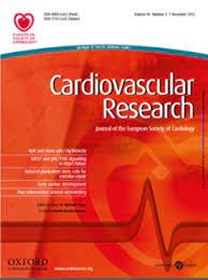心房内向整流钾电流(IK1)的性别和性激素调控:对潜在促心律失常机制的见解。
IF 10.2
1区 医学
Q1 CARDIAC & CARDIOVASCULAR SYSTEMS
引用次数: 0
摘要
在房颤(AF)的发病率中,aims明显的性别差异是已知的。在这项研究中,我们旨在研究可能导致年轻人群房颤发病率性别差异的心房电生理特性,重点关注IK1,一种对动作电位(AP)稳定性和触发活性很重要的心脏离子电流。方法与结果观察健康新西兰小白兔12导联心电图p波形态的性别差异。与女性相比,男性p波持续时间更长,p波面积更大。膜片钳实验采用离体兔心房心肌细胞(CMs)。男性心房CMs的DAD发生率、振幅和曲线下面积(AUC)高于女性,这可能促进了男性心房触发活动的存在。男性心房CMs的静息膜电位(RMP)超极化较低,IK1小50%,IK1的孔形成亚基Kir2.1蛋白表达比女性低26%。研究了体外急性和半慢性双氢睾酮(DHT)的作用。实验表明,DHT可以模拟IK1的性别差异。在女性心房CMs中,急性和半慢性(24小时)DHT可降低IK1。在pkc抑制剂存在的情况下,dht介导的IK1减少未在房性雌性CMs中观察到,这表明它是pkc介导的。在体内研究了雌性兔激素释放颗粒植入后的慢性dht效应。两周后,动物p波明显延长且增大,心房IK1明显减小,DAD振幅和AUC有增加的趋势。结论性别影响心房电生理,导致p波形态、触发活动、RMP和IK1的性别差异。这些性别差异可以通过性激素治疗来模拟,这表明性激素——尤其是二氢睾酮——在调节心房电生理的性别差异中起着关键作用。这种性别差异可能会影响发生房颤的倾向,尤其是在年轻人群中。本文章由计算机程序翻译,如有差异,请以英文原文为准。
Sex and sex hormonal regulation of the atrial inward rectifier potassium current (IK1): insights into potential pro-arrhythmic mechanisms.
AIMS
Pronounced sex-differences are known in the incidence of atrial fibrillation (AF). In this study, we aimed to investigate the atrial electrophysiological properties that may underlie sex-differences in AF incidence in the younger population, focusing on IK1, a cardiac ion current important for action potential (AP) stability and triggered activity.
METHODS AND RESULTS
We assessed sex-differences in P-wave morphology in 12-lead ECG in healthy young New Zealand White rabbits. Males presented longer P-wave duration and larger P-wave area compared to females. Patch-clamp experiments were performed in isolated rabbit atrial cardiomyocytes (CMs). Male atrial CMs presented higher DAD incidence, amplitude, and area under the curve (AUC) than females, potentially facilitating the presence of atrial triggered activity in males. Male atrial CMs showed a less hyperpolarized resting membrane potential (RMP), a 50% smaller IK1, and a 26% reduction in Kir2.1 protein expression, a pore forming subunit of IK1, than females. Dihydrotestosterone (DHT) effects were investigated acutely and semi-chronically ex vivo. Experiments showed that the sex-difference in IK1 could be mimicked by DHT. In female atrial CMs, acute and semi-chronic (24h) DHT administration reduced IK1. In the presence of a PKC-inhibitor, DHT-mediated IK1 reduction was not observed in atrial female CMs, suggesting it to be PKC-mediated. Chronic DHT-effects were investigated in vivo in female rabbits after hormone-releasing pellet implantation. After two weeks, animals showed a significantly prolonged and larger P-wave, a smaller atrial IK1 and a trend towards an increased DAD amplitude and AUC.
CONCLUSIONS
Sex impacts on atrial electrophysiology, leading to sex-differences in P-wave morphology, triggered activity, RMP, and IK1. These sex-differences can be mimicked by sex hormone-treatment, suggesting that sex hormones ‒ particularly DHT ‒ play a pivotal role in mediating sex-differences in atrial electrophysiology. Such sex-differences might impact on the propensity to develop AF, particularly in the younger population.
求助全文
通过发布文献求助,成功后即可免费获取论文全文。
去求助
来源期刊

Cardiovascular Research
医学-心血管系统
CiteScore
21.50
自引率
3.70%
发文量
547
审稿时长
1 months
期刊介绍:
Cardiovascular Research
Journal Overview:
International journal of the European Society of Cardiology
Focuses on basic and translational research in cardiology and cardiovascular biology
Aims to enhance insight into cardiovascular disease mechanisms and innovation prospects
Submission Criteria:
Welcomes papers covering molecular, sub-cellular, cellular, organ, and organism levels
Accepts clinical proof-of-concept and translational studies
Manuscripts expected to provide significant contribution to cardiovascular biology and diseases
 求助内容:
求助内容: 应助结果提醒方式:
应助结果提醒方式:


